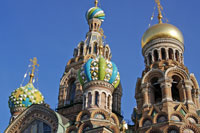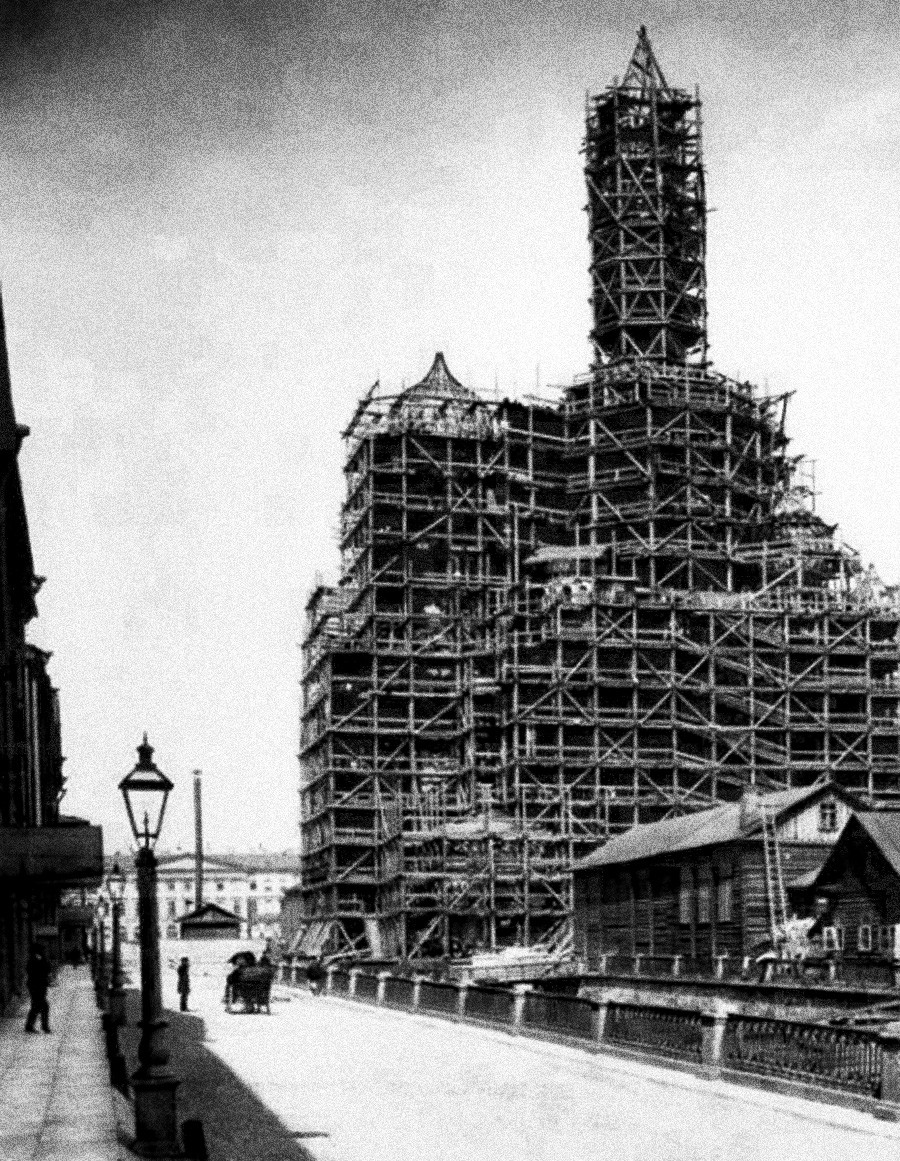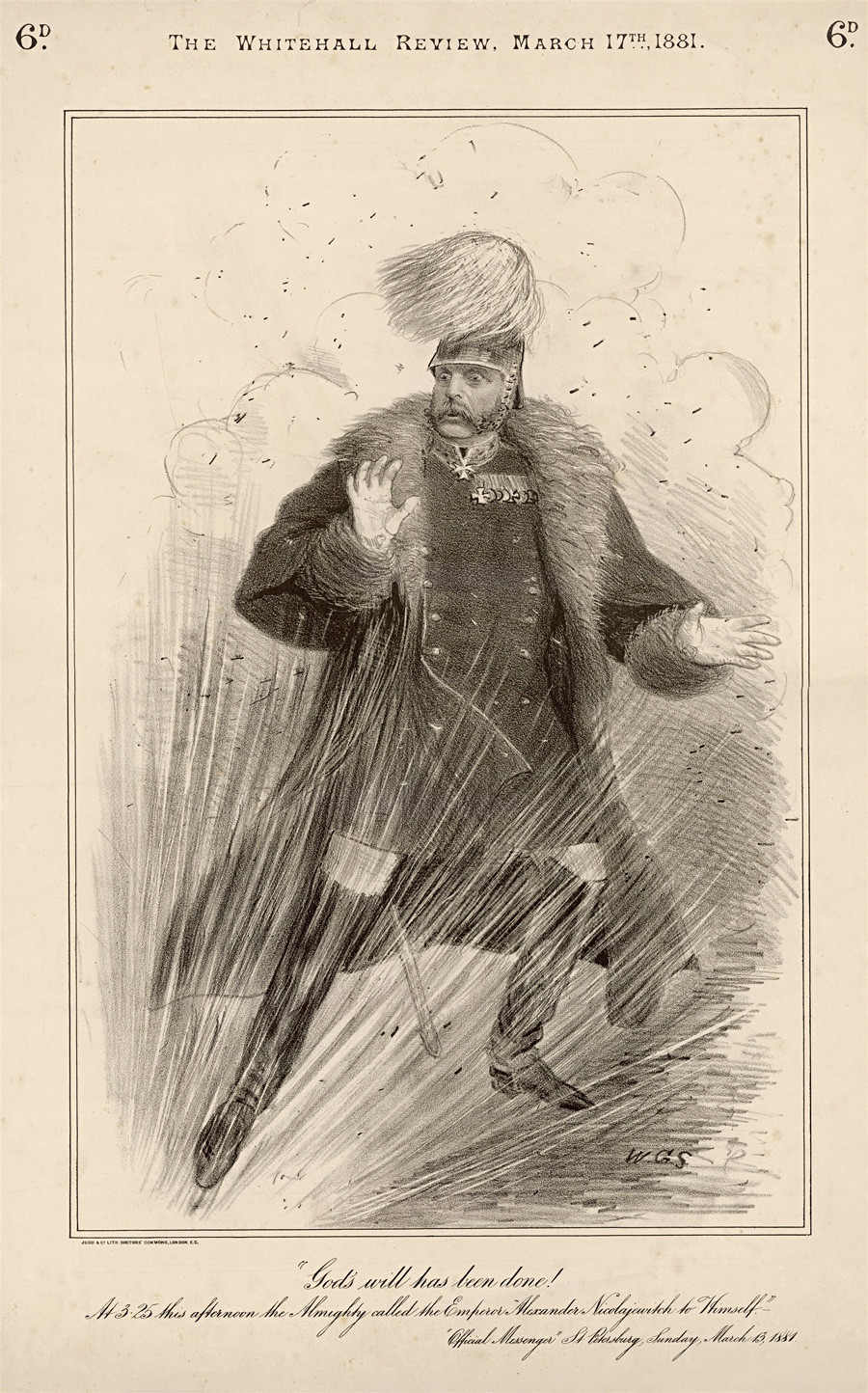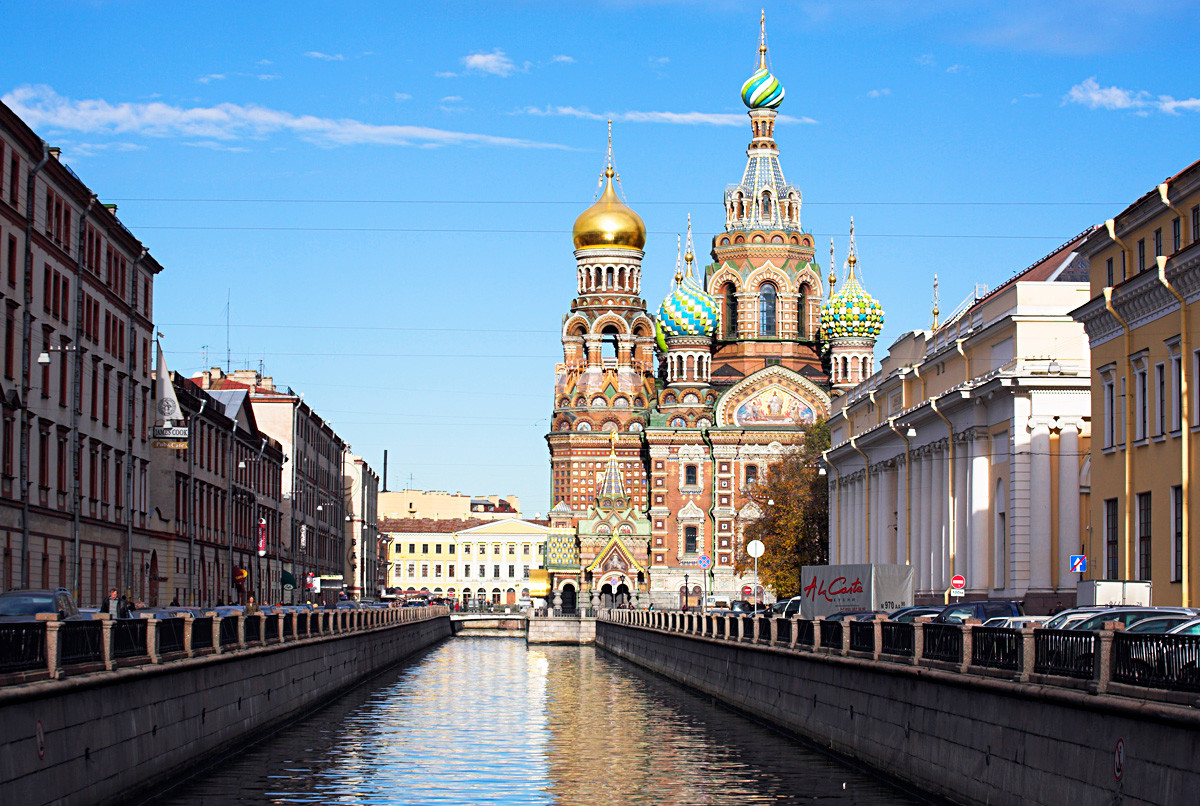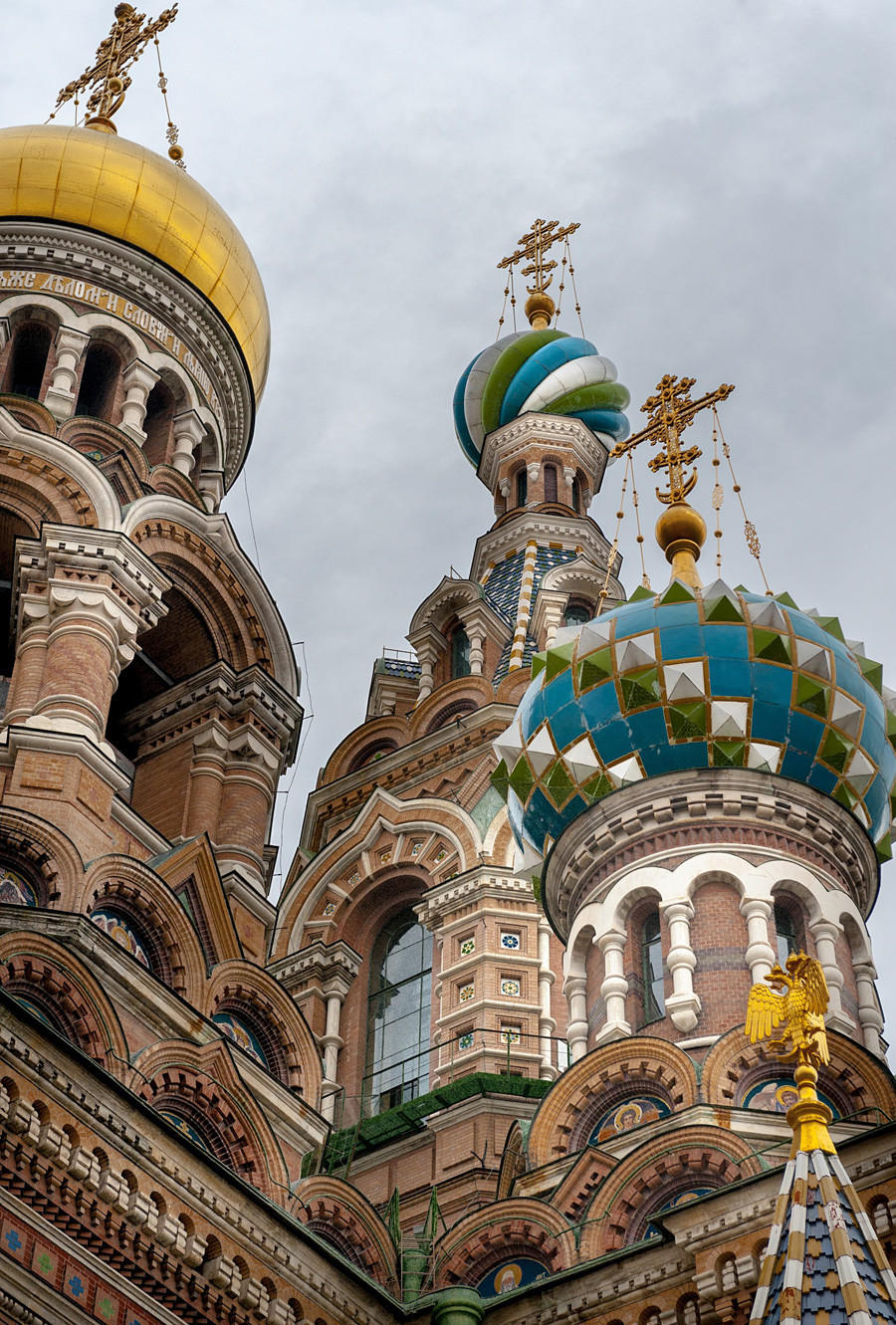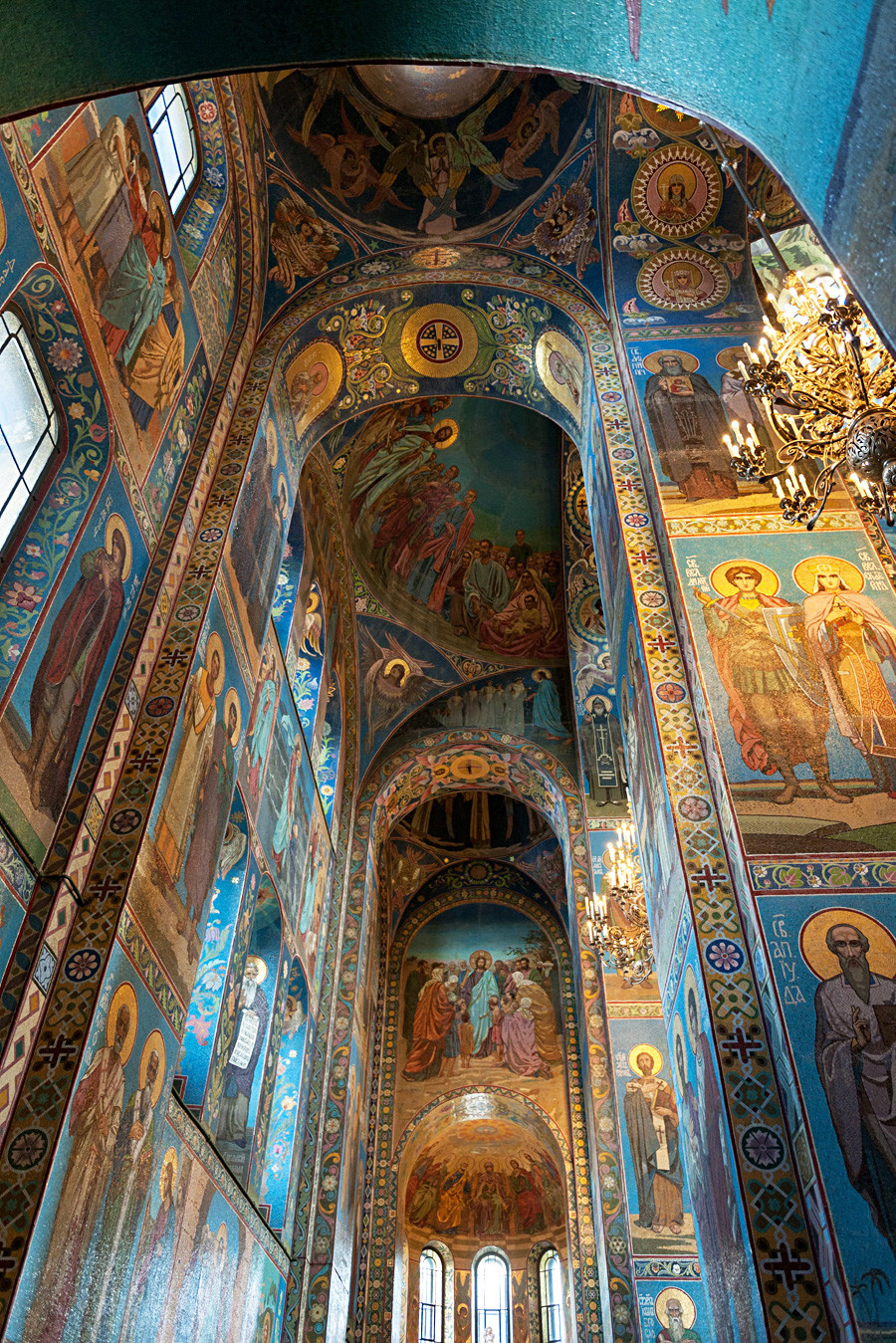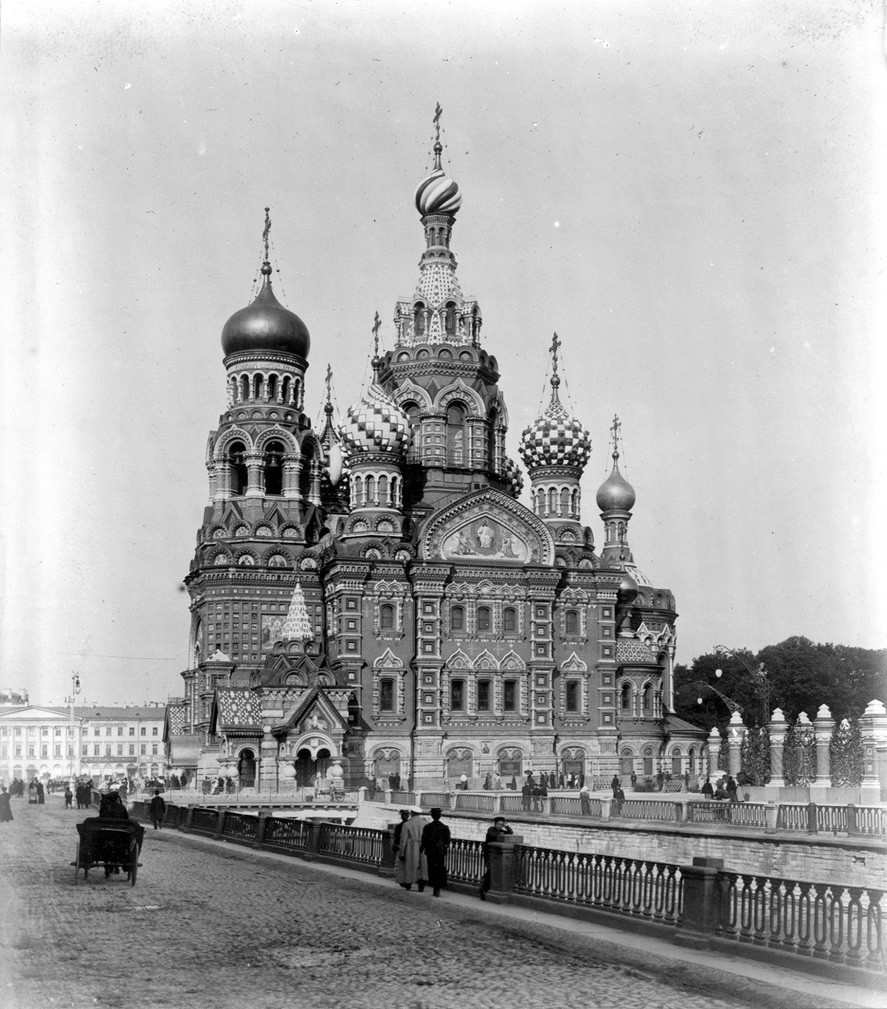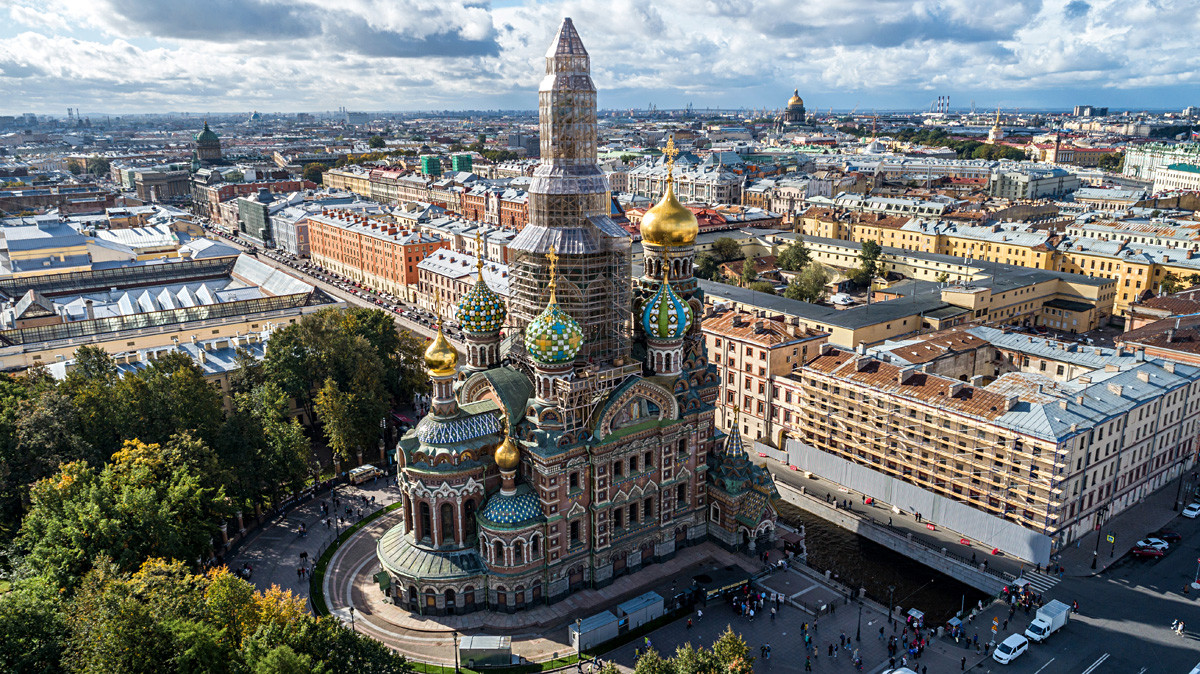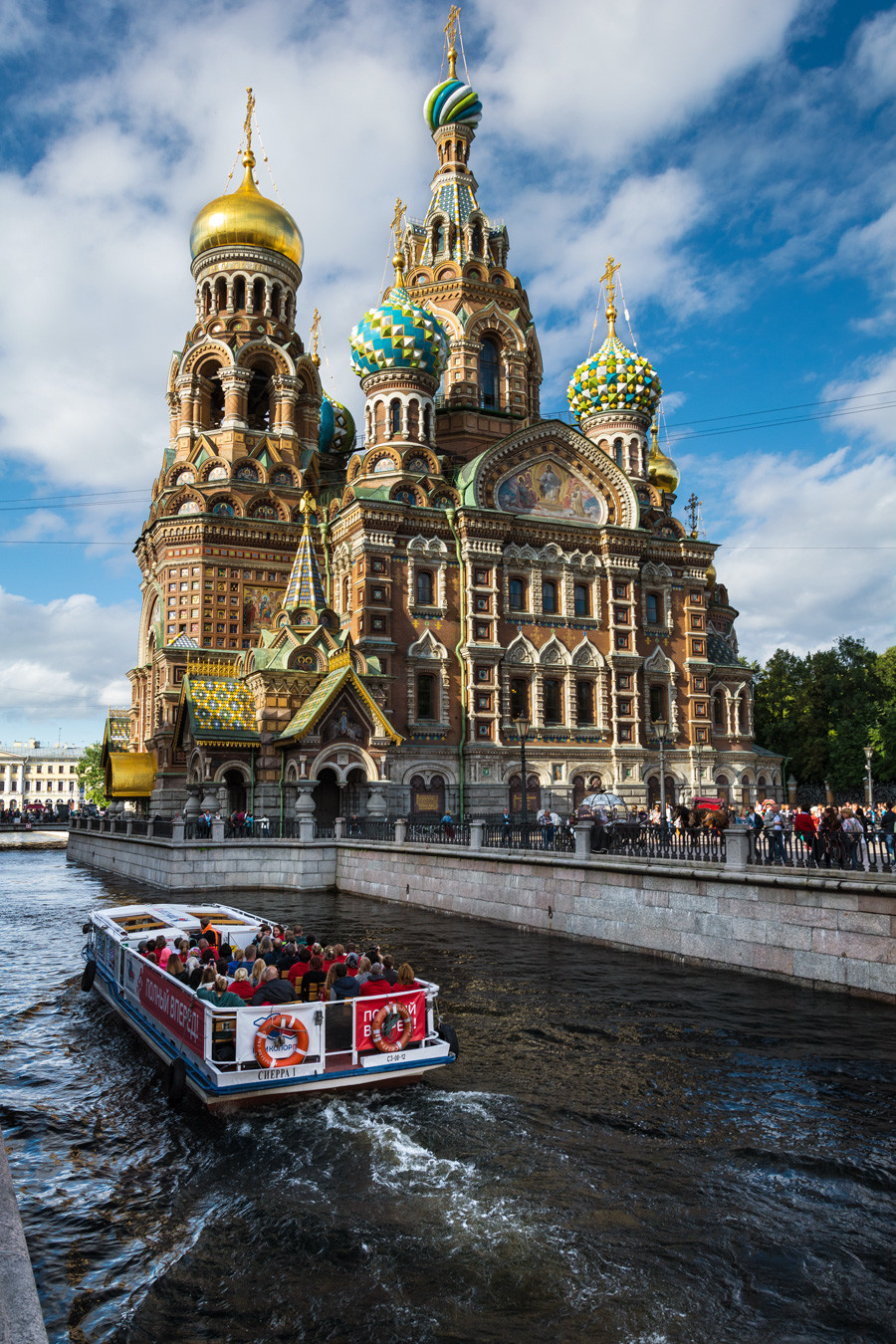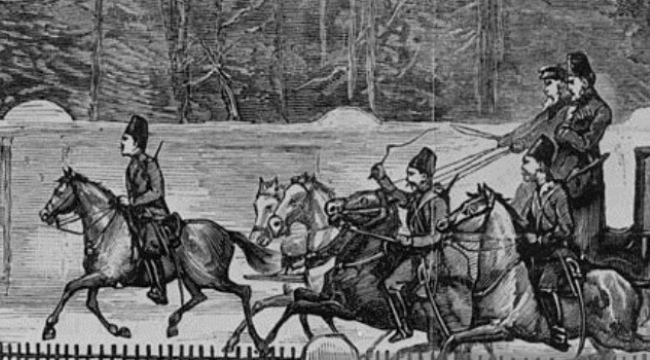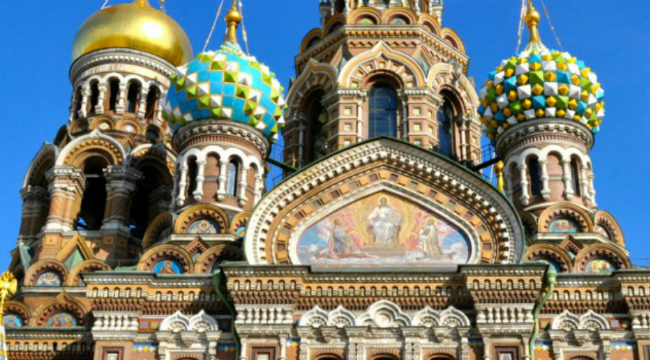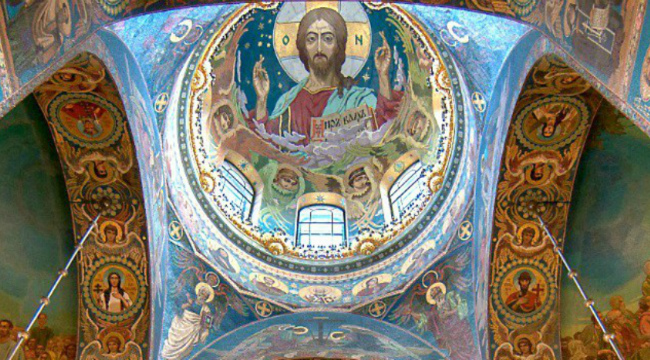The magnificent Church of the Savior on Spilled Blood is one of St. Petersburg’s most memorable landmarks. The church, built at the end of the nineteenth century, is constructed in a classical Russian style decorated with colorful domes and glazed tiles.
Background
Church of the Savior
on Spilled Blood
Officially consecrated as the Church of the Resurrection of Christ, the Russian Orthodox gem more commonly known as the Church of the Savior on Spilled Blood was built to honor tsar Alexander II of Russia, who was assassinated at the site where the church now sits, hence the reference to “spilled blood”. The section of the street on which the assassination took place is enclosed within the walls of the church, and the site of the murder is marked by a chapel in the building.
At the request of Alexander III, son of Alexander II, construction on the church began in 1883. Funding for this amazing structure was almost totally provided by the Imperial family, with other donations made by private individuals. The project was completed in 1907.
The Architecture
The principle architect chosen for the project was Alfred Alexandrovich Parland, who was, incidentally, a non-Russian-born individual. The architecture of the church varies greatly from other buildings and religious structures in St. Petersburg, which were largely constructed in the Baroque and Neoclassical styles. However, the era in which Church of the Savior was built was a time of resurgence of nationalism, thus the classic Russian style of the church.
The domes
Looking at both the interior and exterior, it’s easy to see why the church cost about 4.6 million rubles, way over the budgeted 3.6 million. The outside was designed to mirror the magnificent St. Basil’s in Moscow, the city’s easily-recognizable centerpiece, and the building – both inside and outside – features about 7,000 square meters of mosaics, most of them designed by the prominent artists of the time, including Viktor Vasnetsov, Mikhail Nesterov and Mikhail Vrubel. The majority of the mosaics depict biblical scenes and saints, though some are just patterns. The colorful onion domes, of which the central one reaches a height of 81 meters (266 ft), are covered with bright enamels.
The Church after the Revolution
The church along the
Griboedova canal
During the Russian Revolution of 1917, much of this amazing church was ransacked, and the interior was seriously damaged. In the 1930s, the Soviets closed the church, as they did with most churches in St. Petersburg. During World War II, it was used as a storage facility for food. If suffered yet more damage during the war, and afterward, was used for many years as storage space for a local opera company.
In 1970, St. Isaac’s Cathedral assumed management of the church, and funds garnered from the cathedral (which was, at that time, a museum) were used to restore the Church of the Savior. Restoration was finally complete in 1997 and remains one of St. Petersburg’s top tourist attractions.
- Next: St. Isaac’s Cathedral
Church of the Resurrection of Jesus Christ is known to Petersburgers as the Church of the Savior on the Spilled Blood — or even just the Church on the Blood — as it marks the spot where Alexander II was fatally wounded in an assassination attempt on March 1, 1881. Designed by Alfred Parland in the style of 16th and 17th-century Russian churches, the Church of the Resurrection provides a stark (some would say jarring) contrast to its surroundings of Baroque, Classical and Modernist architecture.
The Cathedral is a unique masterpiece combining the old Russian style of architecture, talent of the best Russian artists and Italian stone carvers, and the art of Roman mosaic. Mosaics cover almost all the surface of the walls and ceilings there are 7 500 square meters of mosaics all in all.
The soviet period history of The Cathedral is nearly as dramatic as the history of its construction. Despite its great artistic and historical value, it was turned into a warehouse after it stopped functioning as an active church in Soviet times. The unique interior was robbed and there were even intentions to blow it up. Luckily this never happened but The Cathedral survived almost by miracle. When eventually the restoration did start, it went on for 27 years (longer than it took to construct The Cathedral). The Cathedral was finally open to public in 1997.
Now you have an opportunity to see the Spilt Blood Cathedral in all its beauty. Do not miss it — it is really worth seeing. We recommend you to take a guided tour during which you will not only observe the magnificent interiors of The Cathedral but also hear its thrilling history in full detail.
Address:
Griboyedov Canal Embankment, 2B, St Petersburg, Russia.
| Persons | 2 | 3 | 4 | 5 | 6 | 7 | 8 | 9 | 10+ |
|---|---|---|---|---|---|---|---|---|---|
| Price per person | 70 € | 50 € | 45 € | 45 € | 45 € | 30 € | 30 € | 30 € | 27 € |
Book Church of the Savior on Blood

The church is particularly popular among foreign tourists. Artists, live music, souvenirs sellers are usually working next to the cathedral.
Why this church is so popular with tourists? There are several reasons for this.
- Exterior of the cathedral combines images of many Russian Orthodox churches. Bright, richly decorated building has features of many Russian churches. Great influence on the appearance of the temple had architecture of St. Basil’s Cathedral in Moscow.
- The interior of the cathedral is unique. All walls, pylons, arches and domes are covered with mosaic. A rich collection of gems, jewelry enamel, colored tiles, made by best artists of that time was used in finishing the building. Inside the temple is a veritable collection of mosaics. The church mosaic collection is one of the largest collections in Europe.
- Cathedral of the Savior on Blood is located in the heart of the city near the metro station “Nevsky Prospekt”. Walking from Nevsky Prospect on the embankment of Griboyedov Canal is the most convenient way to get to it.
Brief history of the cathedral
Church of the Savior on Spilled Blood (Church on Spilt Blood or Cathedral of the Resurrection of Christ ) in Saint Petersburg was built on the place where was attempt to kill Emperor Alexander I. Church is located in the historic center of St. Petersburg on the “Griboyedov” canal embankment. The height of the temple is 81 m.
Construction of the temple began in October 1883. The cathedral was consecrated August 6, 1907. It was decided to destroy the church in November 1931, but this decision was not implemented. The cathedral housed a mortuary during the Second World War. There was a warehouse after the war in the temple. The cathedral was get under state protection in 1968.
The museum “Church on Spilt Blood“ was opened for visitors August 19, 1997. The Cathedral is a branch of the «St. Isaac’s Cathedral» museum. Entrance to the Cathedral is for an extra charge. (Full ticket cost 250 rubles, 2016.)
There are located close to this place: the Russian Museum, the Mikhailovsky Theatre, Mikhailovsky Castle, Summer Garden, the Field of Mars, Nevsky Prospect.
- Address: St. Petersburg, Griboedov emb., 2.
- The nearest metro stations: “Nevsky Prospekt”, Gostiny Dvor.
- You can check the cathedral location on the Saint Petersburg map.
1. Built on the site where the tsar was fatally wounded
No tsar had to endure as many assassination attempts as Alexander II. Six were made in all, the seventh was fatal.
Tsar Alexander II during the murder attempt
Mary Evans Picture Librar/Global Look Press
On the afternoon of March 1, 1881, Tsar Alexander II was returning to the Winter Palace in his royal carriage. On the embankment of Ekaterina (now Griboyedov) Canal, a terrorist threw a bomb under it. Shaken but unhurt, the emperor got out and, so the story goes, thanked God for saving him, whereupon a second conspirator threw another bomb directly at his feet. The tsar died an hour later in his palace chambers.
His son, Alexander III, at the request of the City Duma, erected a shrine in memory of his father at the site of the explosion.
2. Built in the then-outmoded Russian style
A tender was announced for the design and construction of the new edifice. Alexander III insisted that it should adhere to the traditions of church architecture of 17th-century Moscow and Yaroslavl, something highly unusual for St Petersburg, which has practically no old Russian churches, since the city itself was built in the 18th century.
The tender was won by Alfred Parland, an architect with German-Scottish roots, and the religious leader Archimandrite Ignatius. The official groundbreaking ceremony took place in 1883.
Canadian Press/Global Look Press
The cathedral resembles St Basil’s in Moscow Cathedral (although the latter was built in the 16th century). The style would later be called “pseudo-Russian”: built of red brick and crowned with multicolored, enamelled, gilded domes, the whole ensemble seems to resemble a brightly colored folk costume. Above the carved frames of the windows, a series of platbands rises in the form of a kokoshnik (woman’s headdress).
Meanwhile, the base of the bell tower has the appearance of a tiled stove – with tiny square caissons, each of which depicts the coat of arms of one of the Russian provinces that donated funds for the construction, 134 in total (a unique open-air heraldic collection, one might say).
3. Contains more than 7,000 sq. m. of unique mosaics
Canadian Press/Global Look Press
The church took 24 years to build. It is believed that its consecration was delayed due to the complexity of the mosaics by hereditary mosaicist Vladimir Frolov, which he spent ten years perfecting.
Canadian Press/Global Look Press
The luxurious mosaics cover around 7,065 square meters, making it one of the largest mosaic exhibitions in Europe. The work was carried out by the finest artists in the Russian Empire: Viktor Vasnetsov, Mikhail Nesterov, Vasily Belyaev, and many others (30 in total).
4. Operated as a church, but only very briefly
Once the mosaics were complete, the cathedral was finally consecrated in 1907. The official ceremony was attended by the new emperor, Nicholas II, the grandson of the long-dead Alexander II.
However, the church had no parish and gave no public mass. Entry was strictly controlled, and the state allocated money for its upkeep. But after the 1917 Revolution, the authorities cut off the financing, forcing the church to take charge of its own expenses and set up a parish. The local priests, however, did not wish to cooperate with the Soviet authorities, and in 1930 the church was closed and its bells were melted down.
5. Served as a morgue during WW2
In the 1930s-40s, the Bolsheviks destroyed many churches and had their sights set on the Savior on Spilled Blood, too. But WW2 intervened. During the siege of Leningrad (the former name of St Petersburg), it was converted into a morgue where bodies found on the city streets were brought.
After the war, a local theater used the cathedral as a warehouse for stage scenery and props. In the 1950s, the authorities made another attempt to dismantle the church – it supposedly impeded traffic along Griboyedov Canal, since part of the latter had been filled up to make way for the building. But the public protested, and the Savior was saved.
6. Housed an unexploded German shell for nearly 20 years
During the war, the church was repeatedly shelled by German troops, causing serious damage to the walls, which majorly complicated the restoration process afterwards. In 1961, workers were surprised to discover a 240mm high-explosive shell in one of the walls. By some miracle, it had not exploded, but lain dormant and unnoticed for nearly two decades. Its removal was handled by a specialist detonation crew.
7. Now a museum
In the late 1960s, the church was recognized as an architectural monument. It was restored over a period 27 years (three years longer than it took to build), and was reopened in 1997.
Now, the Savior on Spilled Blood works mainly as a museum. On weekdays, tourists come here to view the mosaics and the section of pavement enshrined inside the building where the wounded tsar fell. Services are held here, but only on weekends and church holidays.
Tours by prior booking: cathedral.ru
Correction: In the previous version of this article we erroneously wrote that «in 1930, the church was closed and its domes melted down». In fact, the bells were melted down, not the domes.
If using any of Russia Beyond’s content, partly or in full, always provide an active hyperlink to the original material.
Get the week’s best stories straight to your inbox
Английский язык (Вариант 13)
- 1
- 2
Раздел 3. Грамматика и лексика
Прочитайте приведённые ниже тексты. Преобразуйте, если необходимо, слова, напечатанные заглавными буквами в конце строк, обозначенных номерами 19—25, так, чтобы они грамматически соответствовали содержанию текстов. Заполните поля ответа полученными словами в соответствующем порядке.
Church Calendar
19.THEY
Almost everyone uses calendars. The most common use actually is to mark the passing days and seasons. Quite a few people also mark _____ as diaries or use them to remember birthdays, appointments or other important occasions.
20.BASE
The same is true of calendars ______ on religious experience and most religions have annual festivals on different dates, to remember those things that were most important to them.
21.PROMISS
Those of Jewish Faith follow events that revolve around the Exodus. This was the journey of the Israelites out of Egypt to the new land that they God _____ them.
22.HELP
Although the Christian Church has many different “branches”, most of them have calendars based on the life and ministry of Jesus. The Calendar _____ believers to remember throughout the year the most important aspects of their faith.
23.POPULAR
In the UK, the biggest festivals of the Christian Church are Christmas and Easter. The _____ by far is Christmas and huge numbers visit Church on Dec24th (Christmas Eve) each year to sing carols and remember the birth of Jesus.
24.SET
Some dates in the Church are fixed — others vary. The date for Easter, for example, typically falls between late March and late April (Western Christianity) and early April to early May (Eastern Orthodox). The date _____ by a lunisolar calendar, following the cycle of the moon.
25.PRESENT
As a congregation moves through the church calendar, events _____ in an organized way with the opportunity to talk about different faith confessions. This also helps children to visualise and learn about their religion, history and culture.
Заметили ошибку в тексте?
Выделите её и нажмите Ctrl + Enter

In fact, travelers who visited the capital of Russia probably instantly thought the picture represents the famous St. Basil’s Cathedral in Moscow as both landmarks share many similarities. Another similarity of the sights is the number of names they are both referred to. The colorful landmark of St. Petersburg is also known as the Church of the Resurrection of Jesus Christ, Church on the Spilled Blood, Temple of the Savior on Spilled Blood, and the Cathedral of the Resurrection of Christ. Similarly, the St. Basil’s Cathedral is also known as Cathedral of Vasily the Blessed, Cathedral of the Intercession of the Most Holy Theotokos on the Moat or Pakrovsky Cathedral.
1. History Behind
However, this post is about the Church of the Savior on Spilled Blood and three reasons why you should pay a visit to the top sight of St. Petersburg. One thing that draws travelers to the sight is its fascinating history. The Church was first built in 1883 to honor the memory of Alexander II, who was responsible for the emancipation of serfs in 1861 that put an end to Russian slavery — five years before the emancipation of slaves in the US.
On March 13, 1881, Tsar’s carriage was passing the embankment of Griboedov Canal, where the Church of the Savior on Spilled Blood is situated now when a grenade was thrown by an anarchist exploded. The killing attempt had failed as unhurt tsar got out of his carriage and started to remonstrate with the protestor.
Although, a minute later a second conspirator threw another bomb killing himself and taking Alexander’s II life with him. The site of the attack was marked with a temporary shrine whilst the plans for the more permanent memorial were undertaken.
The Church of the Savior on Spilled Blood Facts
- Location: Saint Petersburg, Russia
- Affiliation: Russian Orthodox
- Style: Russian Revival architecture
- Construction Start: 1883
- Completed: 1907
The construction works began in 1883 during the reign of the tsar’s son Alexander III and were finished 24 years later, during the reign of Nicholas II. The estimated cost of the memorial construction is about 4.6 million rubles, way over the budgeted 3.6 million. The landmark was funded by Imperial family and many private donors. Unfortunately, during the Russian Revolution of 1917, the landmark was greatly damaged and closed by Soviets in the 1930s.
During World War II, the Church served as a storage facility for food and had suffered even more damages and after the war was over it was used again as a storage facility, this time for a local opera company. Once the St. Isaac’s Cathedral took back the management of the landmark and began the reconstruction works, which lasted for 25 years. The Church as we know it now has opened its doors again in 1997 but does not function as a public place of worship.
2. Architectural Splendor
Another significant aspect of the Church, which is usually the main reason that sparks the desire for a visit, is its breathtaking architecture. The Church of the Savior on Spilled Blood differs from other buildings and religious structures in Saint Petersburg. Moreover, a majority of the buildings in the city are of baroque or neoclassical architectural styles, whereas the Church reflects the spirit of romantic nationalism. The Church was modeled after 16th and 17th century the Yaroslavl architectural style of churches (same as St. Basil’s Cathedral in Moscow).
The designated architect of the famous religious structure was Alfred Alexandrovich Parland, who wasn’t born in Russia. The non-Russian architect’s roots could have been the reason why the landmark’s architecture varies greatly from other buildings in the second capital.
3. The Great Mosaic Collection
The third reason why travelers should visit the astonishing landmark of Saint Petersburg is the inside of the Church. The interior will surely take your breath away with 23 130 square feet of the mosaic collection (including mosaics of the exterior) — one of the largest in Europe. The colorful mosaic is based on the paintings of Vasnetsov, Nesterov, and Vrubel. The inside of the main dome of the Church is decorated with the iconic mosaic painting of the Christ Pantokrator and is one of the most memorable art pieces from the Church. There are many more extraordinary examples of art displayed in the mosaic, which is best to see in person. Watch our rep Vera show you around the landmark and tell you more about it:
Did you know?
Some of the most recognized Russian artists, including Viktor Vasnetsov, Mikhail Nesterov, and Mikhail Vrubel, participated in creating the church’s interior. No surprise that the church’s construction went beyond budget: 3.6 million rubles at start of the construction and over 4.6 million at the end.
To summarize, the Church of the Savior on Spilled Blood is a unique sight of Saint Petersburg, that is rich in history and is also an incredible example of Yaroslavl church architectural style with beautiful domes and the mosaic collection. You could visit the famous site of the city during every tour to Russia that includes guided days in Saint Petersburg.
Упражнение 4 для подготовки к ЕГЭ по английскому языку.
Прочитайте текст и заполните пропуски A–F частями предложений, обозначенными цифрами 1–7. Одна из частей в списке 1–7 лишняя.
текстответ
One of Russia’s crowning achievements is the Hermitage Museum, a complex of large and impressive neoclassical buildings located in St Petersburg. The museum was created in 1764 by Catherine the Great and it contains over 3 million items, A _______ .
As well as housing the Hermitage Museum, the imperial family of Russia made their home on the complex, in the Winter Palace, from 1732 to 1917. It was from this location that the emperors of Russia ruled over lands В ________.
The museum’s massive collection of paintings was started by Catherine the Great, when she purchased either 225 or 317 paintings (sources do not agree) from a merchant in Germany С ________. The paintings included works by Rembrandt, Rubens, van Dyck and Raphael.
The operation of the museum during its early years consisted of hundreds of people employed by the Russian monarchy. The complex was also the location of several important events and festivals held by the Russian royal family D _______ . Together with the large collection of art, the complex became a symbol of Russian pride.
The ownership of the Hermitage Museum, its contents and its buildings passed to the Soviet Union after the Russian Revolution of 1917. While some of its possessions were sold secretly, most of the collection remained intact E _______ . Many works were shipped off for protection during the Second World War.
In the 1990s it was revealed that the Hermitage Museum held collections from Germany that had been confiscated by the Red Army. They are an important collection of French Impressionist and post-impressionist artwork F _______ . In 1995 they were displayed for the first time since the war ended.
1. who had compiled a collection initially intended for the king of Prussia
2. and attended by the various nobility of the country
3. including the largest number of paintings of any museum in the world
4. who managed to hide much of the art from invading armies
5. originating from private collections taken during the war
6. and the Soviet government maintained the complex as a public museum
7. that spanned almost one sixth of the Earth’s surface area
A-3; B-7; C-1; D-2; E-6; F-5
Hermitage Museum
One of Russia’s crowning achievements is the Hermitage Museum, a complex of large and impressive neoclassical buildings located in St Petersburg. The museum was created in 1764 by Catherine the Great and it contains over 3 million items, including the largest number of paintings of any museum in the world.
As well as housing the Hermitage Museum, the imperial family of Russia made their home on the complex, in the Winter Palace, from 1732 to 1917. It was from this location that the emperors of Russia ruled over lands that spanned almost one sixth of the Earth’s surface area.
The museum’s massive collection of paintings was started by Catherine the Great, when she purchased either 225 or 317 paintings (sources do not agree) from a merchant in Germany who had compiled a collection initially intended for the king of Prussia. The paintings included works by Rembrandt, Rubens, van Dyck and Raphael.
The operation of the museum during its early years consisted of hundreds of people employed by the Russian monarchy. The complex was also the location of several important events and festivals held by the Russian royal family and attended by the various nobility of the country. Together with the large collection of art, the complex became a symbol of Russian pride.
The ownership of the Hermitage Museum, its contents and its buildings passed to the Soviet Union after the Russian Revolution of 1917. While some of its possessions were sold secretly, most of the collection remained intact and the Soviet government maintained the complex as a public museum. Many works were shipped off for protection during the Second World War.
In the 1990s it was revealed that the Hermitage Museum held collections from Germany that had been confiscated by the Red Army. They are an important collection of French Impressionist and post-impressionist artwork originating from private collections taken during the war. In 1995 they were displayed for the first time since the war ended.


